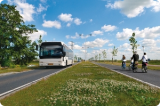
Press Kit - Report "New mobilities in suburban and rural areas"
Vincent Chriqui, Director of the Centre d'analyse stratégique together with Olivier Paul-Dubois-Taine, Chairman of the Working Group, Bridge and Highway Engineer, has released a report by Centre d'analyse stratégique:
"New mobilities in suburban and rural areas"
The suburban and rural areas house 40% of the population (and 60% if small and medium towns covered by public transportation are added to the estimation). These less dense areas have difficulties accessing the services necessary for daily life: they are removed from commercial centers, few local services are available, there is limited public transportation etc. Owning a car is thus a necessity.
Based on the work of the Centre d’analyse stratégique for over a year and chaired by Paul-Olivier Dubois-Taine, this report suggests possible actions reconciling environmental concerns and a model of mobility for everyone all while taking into account energy prices. The recommendations presented can be carried out with modest public expenditures, but requires a substantial amount of information and consultation with residents.
Various factors would be able to help limit society’s dependency on private cars (information systems, coordination of transport modes and services, shared use of vehicles, organized outreach and services etc.).
Even if local initiatives in these areas are growing, their effects remain marginal. How are these isolated initiatives carried out and channeled into significant changes of greater magnitude?
RECOMMENDATIONS
- Assist municipalities and cities, as well as core businesses (universities, shopping centers etc.), that wish to develop mobility strategies adapted to their area, starting with a local understanding of transportation flows and integrating this under the departmental plan and the transportation connections with neighboring urban centers.
- Provide drivers with real time information in order to better organize traffic by combining collective and individual transportation (walking, motorbikes, car or shared).
- Rely on digital information to develop car-sharing, especially car-pooling solutions, based on trusted third parties and location-based tracking.
- Let transportation services with powerful feeders to transit stations (bike routes, carpool parking) coordinate among themselves, in order to create a system of effective door to door transportation. About 10% of annual transportation expenses should be spent on such feeders.
- Limit the distances traveled by professional services (shops, health, recreation, etc.) by encouraging them to coordinate their trips, deliveries or transportation of passengers who use them.
Press Contact:
Jean-Michel Roullé, Head of Communications
Tel. + 33 (0)1 42 75 61 37 - jean-michel.roulle@strategie.gouv.fr
Les ressources
- Dossier de presse [PDF]
- Présentation du Rapport - Les nouvelles mobilités dans les territoires périurbains et ruraux - par Vincent Chriqui, Directeur général du Centre d'analyse stratégique [PDF]
- Présentation du Rapport par Olivier Paul-Dubois-Taine, Président du Groupe de Travail, Ingénieur général des Ponts et Chaussées [PDF]
- Report - The new mobilities in suburban and rural areas
- Policy Brief 262 - A new approach to mobility in suburban and rural areas

